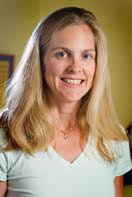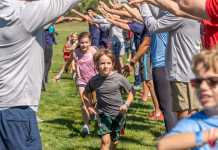Disclosure :: this post is sponsored by The Parenting Center.
Living in a diverse and culturally rich city can make us casual about the topic of race with our children. Parents may feel that exposing children to a variety of art, food, and cultural experiences will provide a basis for an attitude of inclusiveness. Families may choose schools or places of worship based on a diverse population, counting on the personal experience with people different from themselves to nurture tolerance – or even a new generation of “colorblind” children.
Although well-meaning, the idea that we might raise children to see beyond color and gender and treat everyone the same goes against typical development – and may not be good for everyone. Rather than trying to make race invisible, parents can help by recognizing and embracing differences.
We are all different
While equality is important, we are not all the same. And children notice that. From the first year of life, they begin to notice differences and similarities among people. By the time children are in preschool they begin to classify themselves and others and to ask questions – especially about whether attributes can change; “Can I get hair like that?”
Consider that classifications that may divide us also give us our groups – a shared identity and experience and sometimes, a support network. Your child’s personal identity gives him or her a sense of individuality – a name, a place in the family, personality traits, talents, and preferences. Our social identities refer to our groups, which could be racial or gender- related or about ethnicity, religion or geography. People are born into some social identities (race, gender, etc) and grow into others (parenthood, socioeconomic status, and more.) So the ability to identify, talk about, and think critically about identity starts young, at home, and goes on through life. The more accepting you and your family are of differences and the more open to learning, the bigger and richer your child’s world. When we pass along attitudes of judgment or exclusion, we make a child’s world smaller.
Children learn by example
Children start to develop biases and preferences from watching their parents and other trusted adults. Some messages are passed on, intentionally or not, through our language and overt actions; refusing to attend a party in some areas of the city, assuming a child is from a particular school or family, attending community events but gravitating to people who look like you, or speaking in certain accents or dialects to express anger or humor. Passing jokes based on stereotypes send a more powerful and lasting message than simply pronouncing that all people should be treated with respect. Your values will have to be backed up by your words and actions.
 Young children who are being raised to recognize and celebrate all identities start with their own. Help children learn respect and empathy by treating them with such. As they grow into the preschool years and start school, continue to prioritize family values that treat all people with consideration. When your child asks a question or makes an assumption, make sure he or she has good information. Talk about how skin color is passed on the same way other physical traits are passed on. When there is something you don’t know, find out. For example, people often lump race and ethnicity together, basing both on shared physical traits. Ethnicity is the identification of a group based on a shared heritage, nationality, and, often, language. Race is a social construct based on physical appearance, like skin color, hair, and bone structure, that has been used to categorize people and, historically, to rank groups. So people who are categorized in America as Black may be from very different ethnic backgrounds.
Young children who are being raised to recognize and celebrate all identities start with their own. Help children learn respect and empathy by treating them with such. As they grow into the preschool years and start school, continue to prioritize family values that treat all people with consideration. When your child asks a question or makes an assumption, make sure he or she has good information. Talk about how skin color is passed on the same way other physical traits are passed on. When there is something you don’t know, find out. For example, people often lump race and ethnicity together, basing both on shared physical traits. Ethnicity is the identification of a group based on a shared heritage, nationality, and, often, language. Race is a social construct based on physical appearance, like skin color, hair, and bone structure, that has been used to categorize people and, historically, to rank groups. So people who are categorized in America as Black may be from very different ethnic backgrounds.
If you’re not sure where to start, get a good book! For very young children, look for storybooks that include children from different cultures and households that don’t look like yours, such as More, More, More, Said the Baby by Vera Williams and 10, 9, 8…. by Molly Bang. Look for multicultural books like Whoever You Are by Mem Fox. Preschool and young school age children can learn about where skin color comes from in The Skin You Live In by Michael Tyler, The Colors of Us by Karen Katz, and All the Colors We Are by Katie Kissinger. Be intentional about the choices you make every day regarding toys, materials and media and take notice of the cultural norms around you, not just on holidays or at special events. Remember that if something or someone is “other” to you, you are “other” to them.
Tips for Parents
- Answer questions openly and honestly. Remember that if you show shame or discomfort, children are less likely to ask questions and may get their information from other sources.
- Be aware of the social identities in your and your child’s world. Think about your family, your community, and the media your child sees. What is helpful? Harmful?
- Challenge your own perceptions and especially, negative associations.
- Listen to yourself. Do you use words like “normal,” “them,” and “other?” How?
Step out of comfort zone you have grown into. By growing your world a little, you give your child a bigger start!
More information on teaching your children about race can be found on the Teaching for Change and Priceless Parenting websites.
About Jenni Evans
 Jenni Watts Evans has been involved in early childhood education and development from many angles. Beginning in the classroom as a preschool teacher, Jenni moved into advocacy work and adult education as a parent counselor at Child Care Resources of Agenda For Children, where she helped parents find quality child care and trained teachers of young children. Jenni serves on the Board of the Greater New Orleans Association for the Education of Young Children and was on the Anti-Bias Education Leadership Project team. Jenni joined the staff at The Parenting Center in 2002 and became Assistant Director in February 2012. She has two teenage daughters. Jenni shares in staffing The Metairie Center a few days a week and teaches activity, child development, and discipline classes for parents of young children, as well as develops the programming for The Parenting Center.
Jenni Watts Evans has been involved in early childhood education and development from many angles. Beginning in the classroom as a preschool teacher, Jenni moved into advocacy work and adult education as a parent counselor at Child Care Resources of Agenda For Children, where she helped parents find quality child care and trained teachers of young children. Jenni serves on the Board of the Greater New Orleans Association for the Education of Young Children and was on the Anti-Bias Education Leadership Project team. Jenni joined the staff at The Parenting Center in 2002 and became Assistant Director in February 2012. She has two teenage daughters. Jenni shares in staffing The Metairie Center a few days a week and teaches activity, child development, and discipline classes for parents of young children, as well as develops the programming for The Parenting Center.
















